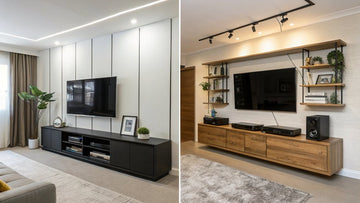Wall-mounted and freestanding TV units each have their own benefits. TV units that attach to walls help save floor space and look neat, while those that stand on the floor are easier to move and offer more storage space. If you have kids at home, wall-mounted units are safer since they can't tip over. Both types affect how you set up your room and watch TV, but you'll need to think about things like how much it costs to install them and how to hide TV cables. Knowing these differences helps you pick the right choice for your home.
Key Takeaways
- Wall-mounted units save space and create modern aesthetics, while freestanding units offer mobility and additional storage options.
- Freestanding units provide flexibility for renters and layout changes, but wall-mounted options minimize tripping hazards and toppling risks.
- Wall-mounted entertainment centers require professional installation, whereas freestanding units are typically ready to use immediately.
- Cable management is easier with wall-mounted units, but freestanding units generally cost less and require no wall modifications.
- Both options enhance viewing experience through proper height and angle adjustments, with wall-mounts offering more positioning flexibility.
Understanding Modern Entertainment Unit Options
Modern homes face a key choice when it comes to TV setups: putting them on the wall or using TV stands that sit on the floor.
As homes get smaller, many people choose wall-mounted TVs to save space and create a clean, modern look.
TV stands that sit on the floor take up more room but come with some benefits. You can move them around more easily, and they give you extra storage space for things like game consoles or movies.
Both types let you pick from many different looks and materials to match your home's style. The right choice mostly comes down to how much space you have, how easy you want the setup to be, and how safe it needs to be - especially if you have kids or pets running around.
Space-Saving Benefits of Wall-Mounted Units
Living spaces are getting smaller, making wall-mounted entertainment units a perfect choice for today's homes.
These smart units make the most of your living room by getting rid of big, heavy furniture and keeping things neat and modern.
Putting TVs on the wall, along with floating shelves and storage spaces, makes good use of wall height. This setup frees up floor space and makes rooms look bigger. You can adjust the TV to get the best view from different spots in the room, and hidden cable systems keep everything looking tidy.
For more ideas on maximizing small spaces, explore our guide on space-saving solutions for compact lounges.
These units do more than look good - they also keep your electronics safe and high up, away from kids and pets.
You can change and adjust wall-mounted units to fit your room size and match your style, making them work just right for your home.
Storage Solutions in Freestanding Designs
Freestanding entertainment units are built to be flexible, offering plenty of storage options for today's homes. These units come with different storage spaces that keep media equipment tidy while making the most of available room.
| Storage Feature | Functionality |
|---|---|
| Drawers | Media Storage |
| Shelves | Display Space |
| Cabinets | Equipment Housing |
| Cable Management | Clutter Control |
These units have lots of storage space to meet different needs while looking good in any room. You can arrange them in many ways to fit your room's layout and storage needs, whether you want to hide electronics or show off decorative items. They come in different materials and styles, making them both useful for storage and nice to look at. With their roomy storage areas, these entertainment centers help keep rooms tidy while making it easy to reach all your media equipment.
Safety Considerations for Both Mounting Types
Safety is key when choosing between wall-mounted and freestanding TV units in today's homes. Wall-mounted units keep TVs out of reach from children and pets, while expert setup ensures safe hanging and correct weight limits. Freestanding units are easy to move but must be set on firm, level ground to stay upright.
- Wall-mounted units can't fall over and help create tidy rooms by hiding cords and wires, which cuts down the risk of tripping that often comes with regular TV stands.
- Expert installers make sure the setup is safe by strengthening walls and using the right mounting brackets.
- Freestanding units need to be placed away from busy walking areas and should be secured with safety straps, particularly in homes with kids and pets.
When picking between these two options, think about both looks and safety, as this choice matters a lot in modern homes.
Style and Aesthetic Impact on Room Design
Entertainment units do more than just hold TVs and equipment - they help shape how a room looks and feels.
When mounted on walls, these units create a modern, clean look by keeping the floor clear, which works especially well in smaller rooms that need to feel more open.
Units that stand on the floor can become the main focus of a room while offering plenty of storage space. They work well in both old-fashioned and modern rooms, letting you arrange electronics and decorations in appealing ways.
The way you choose to place your unit makes a big difference in the room's mood: wall-mounted units create a sleek, modern feel, while floor units make spaces feel warmer and more comfortable.
Both options can help make your room look put-together and well-planned. For comprehensive tips on arranging your entertainment space, check out our guide on lounge furniture arrangement for entertainment spaces.
Installation Requirements and Challenges
Installing entertainment units comes with different challenges based on how you want to set them up.
When mounting units on walls, you need to be very careful about following building requirements, and often need help from experts to make sure everything is safely attached without damaging the walls.
Setting up freestanding units is easier but still needs good planning to make sure the room works well.
Important things to think about when installing:
- Wall-mounted units need you to find wall studs, check how much weight the wall can hold, and use the right mounting tools.
- You might need an expert to check for hidden wires or pipes in the wall before drilling holes.
- Freestanding units are simpler to set up but need smart placement to look good and be easy to use.
Your choice between these two styles affects both how hard it is to set up at first and how easily you can move things around later, so it's important to think about what works best for your long-term plans.
Cost Analysis Between Mounting Options
Comparing wall-mounted and freestanding TV units shows that true costs go beyond just the price tag. Wall mounts cost more at first because you need to pay for setup, while freestanding units are cheaper to buy but might cost more to maintain over time.
| Cost Factor | Wall Mount | Freestanding Units |
|---|---|---|
| Initial Cost | $300-600 | $100-1,000 |
| Installation | $100-300 | No cost |
| Long-term | Minimal | Variable |
Each option offers different value for money. Wall mounts save space, which can help save money later. While paying for installation adds to the starting cost, wall mounts usually last longer and need less upkeep, which evens out the costs over time. People who need to save space should think about both their current budget and future costs before deciding.
Flexibility and Mobility Factors
Beyond price, how easy it is to move your TV unit matters when picking between different styles.
Units that stand on their own are better for modern homes because you can change their setup when you need to. You can move these units around to make better use of space and easily clean or fix things behind them.
- Free-standing units can be moved anywhere, making it simple to change room layouts or move them with the seasons.
- Units mounted on walls stay in one place, and you need experts to make big changes.
- Getting to your equipment is important, and free-standing units make it easy to reach cables, plugs, and other devices.
People who rent, like to change their décor often, or want flexible living spaces really like this moving option.
More people now choose free-standing units in modern home design because they can change their setup without making permanent changes to their home.
Cable Management Strategies
Messy cables behind TV setups can make rooms look cluttered and untidy. There are good ways to handle this problem, whether you mount your TV on the wall or use a TV stand.
When TVs are wall-mounted, you can hide cables inside the wall or use special covers that attach to the wall's surface. This makes everything look clean and tidy.
For TVs on stands, many units come with holes in the back and paths inside the furniture to keep cables neat and out of sight. Both setups work better with helpful tools like cable ties and covers that bundle wires together nicely.
Learn more about keeping your entertainment setup organized in our detailed guide on the perfect media unit cable management and style.
To keep things working well and safe, sort cables by what they connect to and check them now and then. This is extra important in homes with kids or pets running around.
When cables are well-organized, your TV area looks better, and it's easier to fix problems when they come up.
Optimizing Viewing Experience
Once cables are tidy, the next step is setting up the best way to watch TV. You can either mount your TV on the wall or use a TV stand - both work well for good viewing. Wall-mounted TVs let you adjust the height and angle just right, while TV stands make it easy to move your setup and reach the back of the TV.
- Putting your TV on the wall helps make the room look clean and open by getting rid of bulky furniture, making it easier to see from anywhere.
- Wall mounts that tilt and turn help you find the perfect angle to avoid screen glare and watch TV without straining your neck.
- TV stands give you more options to change your room layout, letting you move things around to make TV watching better for everyone when friends and family visit.
Picking between a wall mount or TV stand comes down to your room size and how you like to use your space - both choices can make watching TV more enjoyable.
Frequently Asked Questions
Is It Better to Mount a TV on the Wall or Stand?
Each way of setting up your TV has its own benefits: putting it on the wall saves space and looks neater, with wires tucked away, while using a TV stand lets you move it around easily. Pick what works best for your room and how you want to watch TV.
What Are the Disadvantages of Wall Mounted TV?
Wall-mounted TVs come with several drawbacks. Once fixed, you can't easily move them around like regular TVs. Setting them up can be tricky, and many people need to hire experts to do it right. The mounting process might harm your walls, and you'll find it hard to watch TV from certain spots in the room. Also, you'll struggle to find space nearby for your cable box, gaming consoles, or other devices you want to connect.
Do TVS Look Better on a Wall or Stand?
TVs can look great either on a wall or on a stand - it really depends on your room. Wall mounting gives a clean, modern look and saves floor space, while TV stands add a cozy, classic feel to the room. Both choices can make your room look better if you set them up well and keep the wires tidy.
Is a Mobile TV Stand Better Than a Wall Mount?
Mobile TV stands and wall mounts each have their strong points. TV stands win when it comes to easy setup and moving around, while wall mounts save space and look cleaner on your walls. Your best pick really comes down to what you need most - whether you want to move your TV easily, have extra storage space, or keep wires tidy and out of sight.
Conclusion
The choice between wall-mounted and freestanding entertainment units depends on your living space and daily needs. While wall-mounted designs bring modern minimalism and save floor space, freestanding units provide more storage options and easy relocation. At Timbur, we craft both styles with care, ensuring each piece matches your room's look and enhances your viewing setup. Whether you need a floating display or a solid storage unit, our custom-made entertainment centers fit your space constraints, storage needs, and style preferences perfectly.
For more inspiration on creating the perfect entertainment space, explore our comprehensive guide on TV unit design balancing technology and aesthetics and discover how transform your living room with a custom media wall can elevate your home's entertainment experience.









